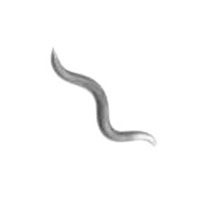Back Up: How Worms Travel in Reverse
 A study of genetically diverse worms finds that the length of their backward movement is under the control of a small protein called a neuropeptide that fluctuates in response to food availability. The research, published in JNeurosci, demonstrates genetic and environmental influences on an animal's exploration of its environment.
A study of genetically diverse worms finds that the length of their backward movement is under the control of a small protein called a neuropeptide that fluctuates in response to food availability. The research, published in JNeurosci, demonstrates genetic and environmental influences on an animal's exploration of its environment.
The roundworm Caenorhabditis elegans moves forward and backward in the shape of a sine wave. A longer backward movement, or reversal, increases the likelihood that the worm will change directions to navigate, for example, toward a food source. How the C. elegans nervous system regulates reversal length has been elusive.
Kavita Babu and colleagues examined strains of C. elegans that differed in their expression of the neuropeptide FLP-18 and its receptors, NPR-4 and NPR-1, and found that this neuropeptide controls reversal length by regulating a circuit that involves sensory neurons and interneurons. Starving the worms for 24 hours increased levels of FLP-18 and resulted in shorter reversal lengths, reducing the probability that they would change direction. This may represent a strategy that enables the worm to explore a larger area for food during periods of extreme hunger.
Article: FLP-18 functions through the G-protein coupled receptors NPR-1 and NPR-4 to modulate reversal length in Caenorhabditis elegans
Corresponding author: Kavita Babu (Indian Institute of Science Education & Research (IISER), Mohali, India), kavitababu@iisermohali.ac.in or kavita.babu@babulab.org





















